Investor Syndicate Blogs
Download The Deal Flipping Playbook

What Is The 70% Rule In House Flipping?
Introduction
The 70% rule is a widely used guideline in the house flipping industry. It's a formula designed to help real estate investors quickly assess the maximum purchase price they should offer for a property to ensure a profitable flip.

The Formula
The rule is calculated as follows:
\text{Maximum Purchase Price} = \text{(After Repair Value) x 70% - Estimated Repair Costs}
Where:
After Repair Value (ARV) is the estimated market value of the property once all repairs and renovations have been completed.
Estimated Repair Costs are the anticipated expenses for fixing and renovating the property.
Practical Example
Let's assume you've identified a potential house to flip. After some research, you determine that once renovated, the house could sell for $300,000 (the ARV). You also estimate that the renovation costs would be $40,000.
Using the 70% rule:
\text{Maximum Purchase Price} = ($300,000 x 0.70) - $40,000
\text{Maximum Purchase Price} = $210,000 - $40,000
\text{Maximum Purchase Price} = $170,000
Based on the 70% rule, you should not pay more than $170,000 for this property if you want to ensure a profitable flip, considering the renovation costs.
Why 70%?
The rationale behind the 70% rule is to account for the flipper's profit and other costs that aren't directly related to property acquisition or repairs. This includes:
Closing costs when purchasing and selling.
Holding costs like utilities, insurance, and property taxes.
Financing costs, if you're borrowing money to buy or renovate the property.
Real estate agent commissions upon selling.
Unforeseen complications during the renovation process.
By sticking to the 70% rule, real estate investors aim to ensure that they retain a good profit margin after accounting for all expenses.
Caveats
While the 70% rule is a helpful guideline, it's essential to understand the local real estate market and property specifics. Market dynamics, property location, and the scale of renovations can influence the profitability of a flip. Therefore, always complement the 70% rule with thorough research and due diligence.
Contact Us

Bet On Yourself
Empowering real estate investors with the tools they need to scale.






